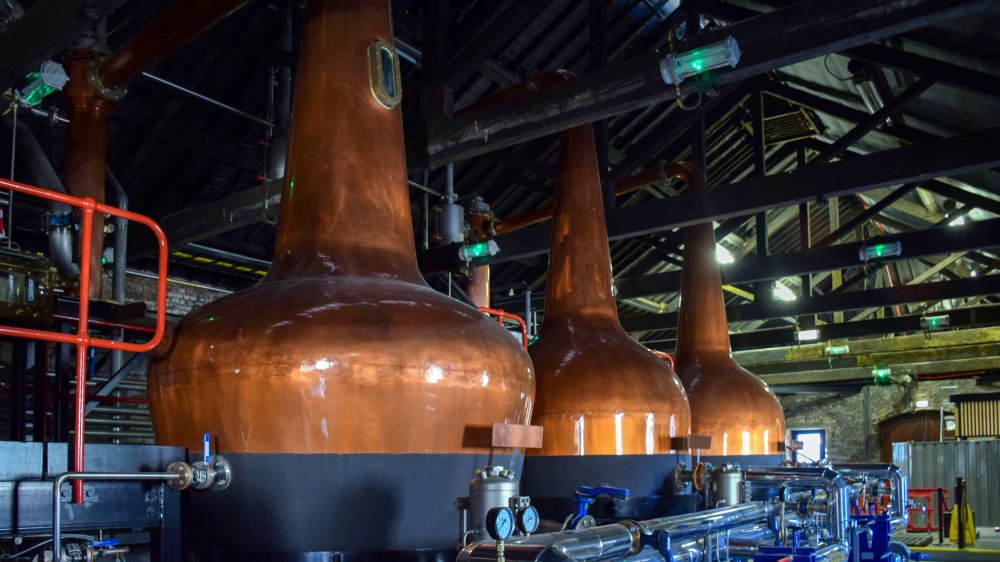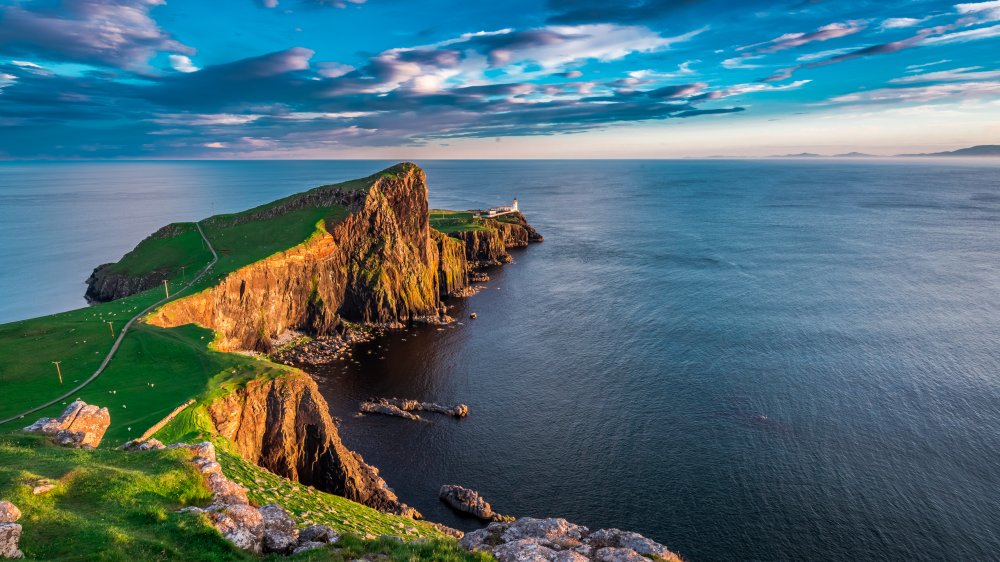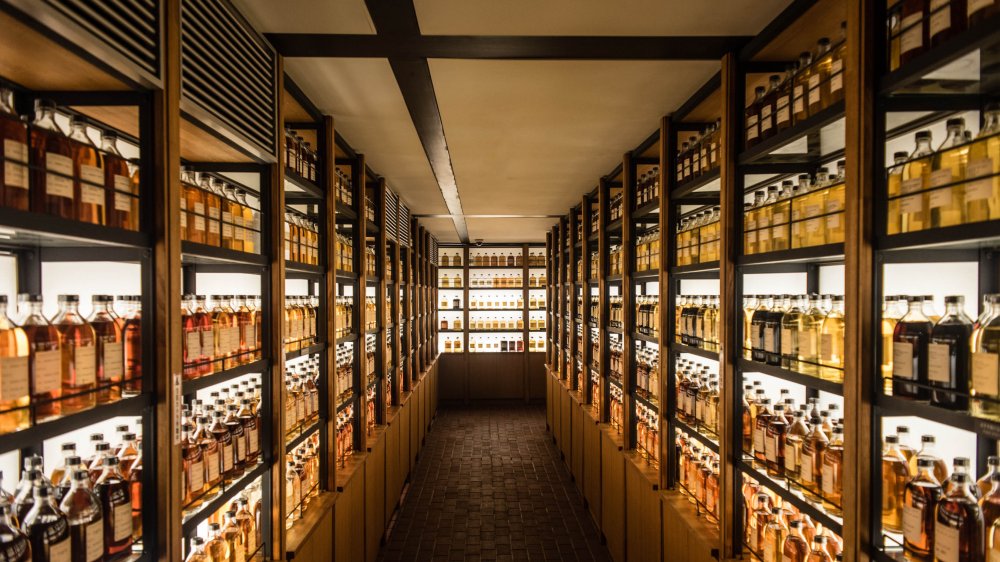What You Should Know Before Taking Another Sip Of Scotch
There's a certain je ne sais quoi to sitting down and sipping on a glass of scotch. Place yourself in a moody library or the sitting room of a historic castle, and you've really upped the ante.
This fine spirit is often consumed either neat in a glass, with a few rocks, or with a splash of water, and scotch aficionados love to take in all the flavor it has to offer. One of the darker spirits, as opposed to clear vodka and gin, scotch offers flavors and notes of honey, caramel, vanilla, spice, smoke, and even fruit, depending on the scotch. And no, it definitely does not taste like butterscotch.
And while's certainly there's a bit of intimidation that comes with the idea of sitting down with a glass of scotch, it may be quite approachable for others. If you're on the first half of that equation, there's no need to fear. We decided to dive in on the history of scotch and the ways people love to enjoy it to learn a bit more about this fascinating spirit. This is everything you should know before taking another sip of scotch.
Scotch is the whiskey of Scotland
When it comes to whiskey, there's a multitude of varieties to become familiar with. And depending on the area the whiskey is coming from, the spelling may differ. It will either be spelled "whisky," or in the case of scotch, it will be known as scotch whisky.
Bourbon, scotch, Irish whiskey, and rye all live in the same category of whiskey, but each has its own distinction based on how and where the spirit is made. As the saying goes, all scotch is whiskey, but not all whiskey is scotch.
While bourbon must be made in the United States to be considered bourbon and Irish whiskey is required to be made and aged in Ireland, the same goes for scotch. To be considered scotch, the spirit must be produced at a distillery in Scotland. Along with production, it must also be aged in Scotland.
Scotch has been around for centuries
Scotch is not a new spirit on the market by any means. In fact, it's been around for centuries.
The earliest mention of scotch dates back to 1494 with the first mention of distilling in Scotland in historic tax records. Scotsman Friar John Cor had purchased plenty of malted barley to make "aqua vitae" (or "water off life"), producing 1,500 bottles of a strong spirit that was revised and perfected over multiple years.
Over time, scotch was produced more frequently and grew in popularity, especially throughout Scotland's cold winters. With so many producers selling their product, Scottish Parliament took notice and imposed the first tax on spirits in 1644. But that only led to more people making scotch illegally. The Duke of Gordon made waves in the industry with a proposal to Scotland's House of Lords that the government promote the distillation of scotch and make it profitable as an export, introducing the Excise Act in 1823. The act sanctioned scotch to be made in exchange for a license fee. With the incentive in place, the scotch industry became legitimate, and most of the smuggling died out quickly.
Scotch has some specific production requirements
Just as bourbon must be produced in the United States, scotch must hail from Scotland to get the prestigious designation on its label. But there are quite a few other requirements scotch makers must adhere to if they want to produce real scotch.
Scotch is always made with water and malted barley in the mash, with other optional cereal grains such as wheat added to the mix. When it's distilled, an official scotch should not reach an alcohol by volume rate higher than 94.8 percent. Once distilled, the scotch is ready to be put into barrels, but it must be aged in matured oak barrels for at least three years in order to be considered scotch. And of course, that aging needs to take place in Scotland.
Once it's ready to be bottled, the final ABV should be no less than 40 percent. To reach that ABV, water and caramel coloring can be added, but nothing else is allowed to be introduced to the final product.
There are multiple types of scotch
As with any spirit, there are multiple ways to follow the requirements established for making that spirit while putting a twist on the traditional. And many scotch distilleries do just that.
It's not uncommon to hear about single malt scotch, and that variety all has to do with the base of the spirit. Scotch must be made with malted barley, but it can have other cereal grains added in. However, those distilling single malts decide to skip any other grain additions, letting the flavor of only the barley being used shine through. Single malt scotch should also be distilled at a single distillery.
Blended scotch is another variety you'll often see, which is the result of a distillery combining multiple whiskeys with a variety of neutral grain spirits. Often, this method is utilized to blend a scotch that was produced at a higher quality with one of a lesser quality to stretch the product and offer a more balanced finished product.
Scotch gets its color from the barrel
For a spirit to be considered scotch, it has to sit in the barrel for three years in Scotland. But it's not just an arbitrary requirement for the product to just sit on its home soil. The barrel actually does quite a bit to the spirit as it's housed in there for years.
When scotch comes off the still, it's entirely clear. But the barrel changes that, resulting in the golden-brown color we see in bottles. Scotch is typically aged in used bourbon barrels because of the characteristics of the American oak. Bourbon requires a new barrel for each batch of booze, so once it's used once in the U.S., it's tossed out. Many of these barrels make their way to Scotland, where they lend their rich flavors to the scotch housed inside.
The spirit takes on the characteristics of the charred interior of the wooden barrel, which is what gives off the flavor notes of honey, vanilla, caramel, and spice, along with the distinct color. Because alcohol is a solvent, it ends up soaking up the pigments from the brown interior of the barrel.
Scotch is traditionally consumed with water
If you've ever heard someone walk up to the bar and ask for a scotch and water, they're probably the person to take drink advice from. Scotch and water is a traditional combination, and for those who actually hail from Scotland, it's the only way to enjoy the spirit.
Scotch is meant to evoke an experience, and sipping the spirit brings a multitude of flavors to light. According to Business Insider, if you want to drink scotch like a Scotsman, added water is actually a necessity — and it's not just used to dilute the alcohol.
When water is added, it's typically only a splash or a few drops, but it changes the experience exponentially. According to one study, when water is added to scotch, the structure of short-chain alcohols change, bringing diluted clusters to the surface of the glass. The water brings out the flavors of the scotch as you swirl it in your glass, taking you through an experience of flavors from orange and cinnamon to chocolate.
Scotch is continuing to grow in popularity
If you're heading out to the bar on a Friday night, chances are, scotch isn't typically going to be your go-to order. Bar orders often consist of vodka or gin because that's the type of cocktail you can sip quickly to get a buzz before you move on to the next bar.
Scotch is meant for sipping, and while you won't necessarily find the orders of scotch stacking up at a college bar, it's definitely still growing in popularity.
Scotch is exported to hundreds of different markets all over the world, including large exports to Asia, South America, and Africa. As of 2018, the scotch market was valued at nearly £4.9 billion, and it looks like that number will only continue to grow. It will be interesting to see if scotch makers can keep up with demand considering scotch must be in the barrel for three years before it's bottled and distributed.
There are designated scotch regions
There are certainly many requirements to meet when you're making scotch, the most important of which is the fact that the spirit must be produced in Scotland. But the geographic location classifications of scotch production goes even deeper than that. Scotland actually designates five specific scotch-producing regions across the country, and often, each region plays a role in the different characteristics that shine through in the final product. The production region is noted on the label.
Speyside, Lowland, Highland, Campbeltown, and Islay all produce different types of scotch within Scotland, with various notes from each of these varieties being more prominent than others. Speyside scotch is known for fruity scotches with notes of apple, pear, vanilla, and honey shining through, while Campbeltown scotches are typically super-powerful and full of flavor, with notes of smoke, salt, toffee, and vanilla. Highland is an island region, so the scotch takes on island characteristics, with salty coastal malt notes that lends itself to a lighter scotch, while Lowland scotch features more of a grassy, earthy palate with notes of honeysuckle and cinnamon. And as for Islay? It's a whole island of its own, with a huge focus on scotch production, putting out tremendous smoky-flavored, or peated, scotches.
Scotland exports a ridiculous amount of scotch
It's true: Scotch really is a major deal for Scotland. Employing more than 10,000 people across the country, the scotch industry in Scotland is incredibly robust. And all of those employees are supporting 133 distilleries throughout Scotland that produce scotch.
All of those distilleries are working to keep up with the rate at which Scotland is exporting scotch because drinkers around the world sure seem to love the stuff. It's certainly not just staying within the country for Scotsmen only to enjoy.
According to the Scotch Whisky Association, every second of the day, 42 bottles of scotch are shipped from Scotland. At that rate, the number of bottles being shipped totals over 1.3 billion bottles every year. The export industry for Scotland is worth over $6 billion, accounting for a significant percentage of Scotland's overall exports. And that number only continues to grow. In 2019, export rates to Asia and Africa grew at rates of 9.8 percent and 11.3 percent, respectively.
Scotch should be stored in a specific way
As it turns out, throwing your bottle of scotch anywhere you'd like to in your house or your freezer isn't going to cut it. Fine scotch requires a bit of finesse when it comes to storing it correctly.
Scotch requires specific conditions when it comes to light and temperature, and if you have a bottle you're planning to sit on for a long time, it's definitely important to store it properly. Direct light on your scotch can totally change the color of your scotch, which can in turn change the flavor or your favorite sipper. Scotch is typically bottled in clear glass, making it vulnerable to light and sun, allowing for the product to change along the way. And because the sun can affect scotch, temperature certainly can too. When temperatures get warm, the scotch can expand in the bottle, forcing the stopper to pop open if it gets too hot. And that's definitely not a mess you want to clean up.
To avoid any potential harm to the bottle or the precious liquid inside, scotch should be stored in a cool, dry place away from direct light. And to avoid any interaction between the scotch and the bottle stopper, it should be kept upright.
You can keep a bottle of scotch for a really long time
When it comes to certain types of alcohol, some are definitely better consumed right away without sitting on them too long. On the other hand, beverages like wine are sometimes meant to be aged, depending on the varietal. But with scotch, it won't change with age, so it's totally fine to sit on it for a while.
Scotch does all of its aging in the actual barrel, so by the time it's bottled, it won't age any longer. If you've opened your bottle, it will stay relatively unchanged for one year if you've stored it away from direct sunlight and heat. Wait any longer than a year since you opened the bottle, and oxygen starts to make its way in and affects the flavor.
But something unopened? It can last indefinitely. According to the Scotch Whisky Association, you can easily keep a bottle for 100 years. The age comes with the barrel, not the age of the bottle. So even if you wait 100 years before opening a ten-year-old bottle, it will still have that same ten-year-old taste.
A single bottle of scotch once sold for $1.9 million
If you're a die-hard scotch lover, you may be willing to pay a hefty penny for a good bottle of scotch. But are you willing to pay almost $2 million, as one scotch lover did? In 2019, a single bottle of scotch sold at Christie's Auctions in London for $1.9 million, taking the crowd by storm.
The item was a Macallan fine and rare collection scotch with quite a bit of history packed into the bottle. Bottled from Cask 263, the Macallan bottle featured scotch that had been maturing for six decades, which was then bottled in 1986. Can you imagine a barrel sitting full for 60 years? The scotch had been originally distilled in 1926, and only 40 bottles were actually drawn from the cask, making it a highly sought-after scotch.
But because you can keep scotch for an incredibly long time, the Macallan 1926 isn't the only rare, old scotch found on the auction circuit. A bottle of Glenlivet from 1862 sold in 2013 for almost $8,000, along with a 1937 bottle of Glenfiddich that sold for almost $100,000 in 2016.
Scotch can be used to make a great cocktail
Scotch is often considered the ultimate spirit to sip and enjoy neat or on ice, right next to bourbon, of course. These liquors are typically meant for sipping and savoring every nuanced flavor along the way. And although scotch can certainly stand on its own, it also makes for a lovely addition to a cocktail.
The Rob Roy is basically a Manhattan with the bourbon swapped out for scotch, but it's been around a long time. Created in 1897, the cocktail combines scotch with sweet vermouth and bitters to create an aromatic beverage.
The Rusty Nail is another perfect scotch cocktail, showing off the nuanced flavors of the spirit with a bit of spice on the palate. This cocktail debuted in 1937, pairing scotch and Drambuie, a scotch liqueur with flavors of honey, herbs, and spices to give a cocktail an herbaceous kick.













